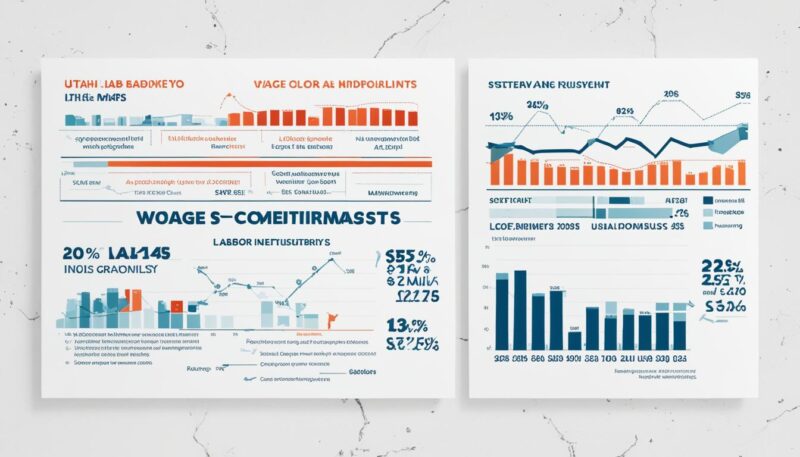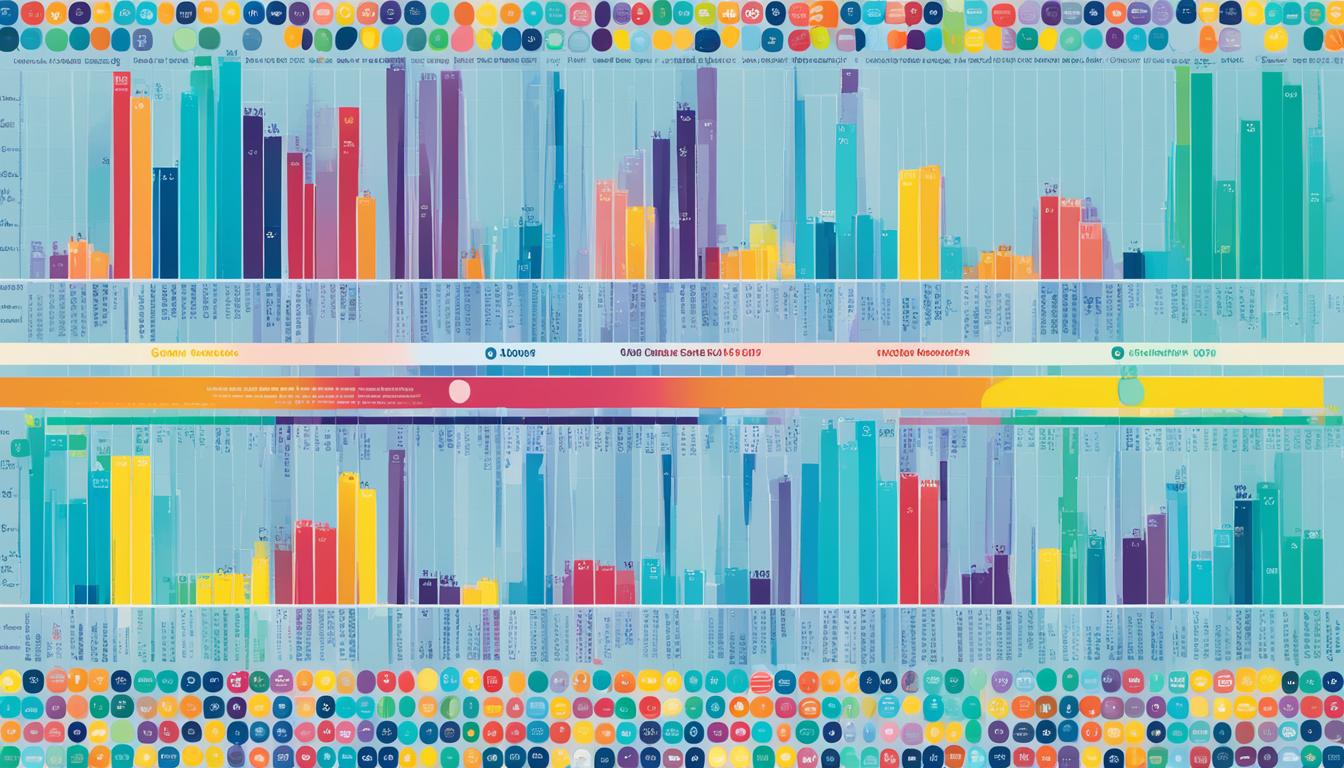The topic of Wages in Utah 2024 garners significant attention as individuals and businesses alike seek to navigate the evolving economic landscape of the Beehive State. With an eye towards the future, a deep dive into Utah salary data offers valuable insights into the fiscal pulses that drive the state’s workforce. The upcoming analysis provides a detailed exegesis of Utah labor market analysis, illuminating projected shifts in the job market that could herald changes for wage-earners across industries.
Key Takeaways
- Anticipated average income levels for Utah’s workforce in 2024.
- Identifying salary trends set to influence Utah’s labor market.
- How state economic reports and labor market expert insights carve out future wage predictions.
- Forecasting the impact of job market statistics on overall wage growth.
- Analyzing shifts within key industries and their respective wage adjustments.
- Understanding the role of inflation and cost of living in determining realistic wage expectations.
Overview of Utah’s Current Wage Climate
As we move through the year 2024, a comprehensive understanding of Utah’s economic landscape is imperative for anticipating the future of its labor market. Recent Utah wage trends suggest that income levels across various sectors have experienced notable shifts, reflecting a dynamic economic environment within the state. The Utah wage forecast, entwined with these shifting patterns, provides valuable insight into the current financial well-being of its workforce. This section will delve into the state’s latest wage data and analyze the historical progression of income figures across distinct industries.
State labor officials, complemented by expert economists, have weighed in on the multifaceted factors driving these wage trends. With these authoritative voices, we acquire a nuanced perspective of the financial currents and undercurrents shaping today’s wage climate in Utah. This professional discourse not only articulates the numerical data but also provides a contextual framework that unveils the story behind the statistics.
| Industry Sector | 2023 Average Wage | 2024 Projected Wage | % Change |
|---|---|---|---|
| Technology | $85,000 | $90,000 | 5.9% |
| Healthcare | $60,000 | $63,000 | 5% |
| Construction | $45,000 | $47,250 | 5% |
| Education | $50,000 | $52,000 | 4% |
| Manufacturing | $40,000 | $42,000 | 5% |
The table above demonstrates the trajectory of average wages by industry sector in Utah over the past year. The trend data provides a clear depiction of moderate yet steady wage growth—a testament to the state’s resilient economy. Furthermore, the percentage change column elucidates the relative pace of wage increases, allowing for a comparative lens through which one can evaluate sector-specific performance.
“The wage increases we’re observing across Utah’s major industries are a reflection of the state’s robust economic strategy, fostering an environment where businesses can thrive and, consecutively, remunerate their employees more generously,” states a leading economic analyst.
The progressive tendencies in Utah’s wage climate denote an optimistic horizon for the working population. However, with these upward trends come further considerations, such as how these shifts align with the broader national wage landscape, which will be explored in the ensuing sections.
Key Factors Influencing Wage Trends in Utah
Utah’s economic landscape is constantly evolving, with a myriad of factors playing a pivotal role in shaping wage trends. This section deeply investigates the elements that contribute to the fluctuations and projections of wages within the state, uncovering the intricacies of the Utah labor market analysis.
State Economic Policies and Their Impact
State-driven economic initiatives have far-reaching effects on wage scales. In Utah, recent tax reforms and business-friendly incentives are designed to attract and retain companies, which in turn drive up the demand for skilled labor. Workforce development programs also invest in local talent, ensuring that Utahans are well-equipped for the emerging job sectors. These legislative moves and investments by Utah’s government are expected to create a ripple effect through various industries, influencing both Utah wage comparison and income projection.
Shifts in Industry Demands and Job Availability
Utah’s industrial landscape is a melting pot of traditional and innovative sectors. The state’s emphasis on tech and healthcare has led to increased job creation, directly impacting wage trends. Labor market reports indicate a trend towards higher wages in these burgeoning sectors. Conversely, industries facing a decline are seeing a shift in job availability, necessitating an assessment of current skill sets and a push towards retraining to meet new industry needs. These dynamics are crucial in understanding and forecasting Utah wage trends.

Analysis of Inflation and Cost of Living Adjustments
One cannot overlook the influence of inflation and cost of living adjustments on wage levels. The weight of economic pressures on Utah residents is significant, and wage adjustments are frequently discussed in terms of their adequacy to meet these pressures. The consumer price index serves as a benchmark for these adjustments, directly correlating with trends in Utah salary data. As such, the relationship between the macroeconomic environment and individual wage changes provides a comprehensive glimpse into the future financial well-being of Utah’s workforce.
Wages in Utah 2024: Projected Growth and Expectations
As we delve into the Utah wage forecast, it’s clear that the state is on a trajectory of economic growth that is expected to be reflected in its job market statistics. The upcoming year holds promise for a variety of sectors, with projections indicating both potential increases in some industries and stabilization in others. Below, we examine the anticipated wage trends that are poised to shape Utah’s labor market in 2024.
Data gathered from the Utah Department of Workforce Services and other economic analysis entities point to specific sectors where wage growth is anticipated to be particularly robust. These figures are more than just numbers—they reflect a dynamic job market in Utah that adapowers employees and businesses alike. Attention to these statistics will be crucial for job seekers looking to find competitive salaries as well as for employers aiming to attract and retain top talent. The following are some of the sectors with noteworthy wage growth expectations:
- Technology & IT Services: Continued expansion is forecasted, bolstered by Utah’s growing reputation as a tech hub.
- Healthcare: With an aging population and advances in medical technology, health services demand is likely to drive up wages.
- Construction: A burgeoning housing market and infrastructure projects may lead to increased wages in the construction sector.
Amidst these growing industries, the wages in some sectors may see minimal increases, reflecting broader economic pressures and industry-specific challenges. Understanding these complex dynamics is essential for stakeholders across Utah’s job market.
“Utah’s labor market is turning a new chapter with prospective wage increases testament to the state’s economic resilience and strategic industry development,” notes a lead economist at the University of Utah.
In conclusion, while forecasting is an inexact science, the indicators are optimistic for Utah’s job market in the year ahead. Workers in various sectors can anticipate a wave of opportunity, and employers must be ready to offer competitive wages in order to thrive in this promising economic landscape.
Comparative Wage Analysis: Utah Against National Averages
In the context of the United States, Utah’s labor market presents unique wage variations. This section dives deep into comparative analyses that pinpoint where Utah’s wage levels stand relative to national figures. Understanding Utah wage comparison, wage trends, labor market analysis, income projection, and job market statistics is instrumental in gauging the economic positioning and growth potential of the Beehive State.
Positioning Utah in the National Economic Landscape
Utah’s position in the national economic landscape reveals a multifaceted picture of its earning dynamics. A Utah labor market analysis shows that, in several professions, the state closely trails the national average, while in others, it sets the benchmark for competitive compensation. This is a testament to the state’s robust economic environment and its commitment to fostering a skilled workforce.
Utah’s Competitive Edge in Salary Offerings
Employee remuneration in Utah often eclipses that of other states, particularly in technology and healthcare sectors. By examining Utah wage trends, it becomes clear that the competitive edge extends beyond mere salary figures, encapsulating benefits, work culture, and career progression opportunities that greatly appeal to job seekers.
The Role of Local Industries in Shaping Wage Scales
The very backbone of Utah’s well-rounded wage structure is its array of burgeoning local industries. From mining to information technology, the influence of these key sectors is significant in the formation of wage scales. And with future income projections for Utah indicating growth, these industries’ roles will likely only become more pivotal.
| Industry | Utah Average Wage | National Average Wage | Projected Annual Growth |
|---|---|---|---|
| Information Technology | $85,000 | $88,240 | 2.5% |
| Healthcare | $75,000 | $72,220 | 3.2% |
| Mining and Extraction | $68,000 | $65,360 | 1.1% |
| Advanced Manufacturing | $60,000 | $58,540 | 2.0% |
| Retail | $32,000 | $31,460 | 0.5% |
Conclusion
As we look towards the upcoming year, the Utah wage forecast paints a well-defined picture of growth and adaptation. Understanding that the statewide economic policies have set a stage favorable for wage increments, we see a direct influence of such strategies on the overall labor market. The analysis affirms that thoughtful legislation coupled with investment in workforce development bears fruit in shaping a robust wage structure. Moreover, Utah’s proactive approach towards tailoring its policies to benefit both the employees and industries suggests a promising augmentation of the Utah salary data.
Recognizing shifts in industry demand is crucial, and for Utah, it has been found that salary offerings have been affected accordingly. Essential sectors experiencing growth have pulled up the average wage, while the more stagnant areas watch the wage curve with anticipation. As these industries evolve, the ripple effect on Utah’s wages compared to the national averages becomes quite clear. It’s an intricate balance, one that sees Utah not merely competing but often exceeding national wage trends, thereby solidifying its economic stability and drawing attention from job seekers and investors alike.
In light of the insights gathered, it is evident that the future of Utah’s economy revolves around its agility in responding to economic pressures and its dedication to maintaining a competitive edge. The informed statements from experts reflect confidence in Utah’s labor market trajectory for 2024. By staying vigilant and responsive to the dynamic economic environment, Utah is well-positioned to navigate through the challenges and opportunities that the new year is expected to bring.
